10 Best Things to Do in Great Sand Dunes National Park
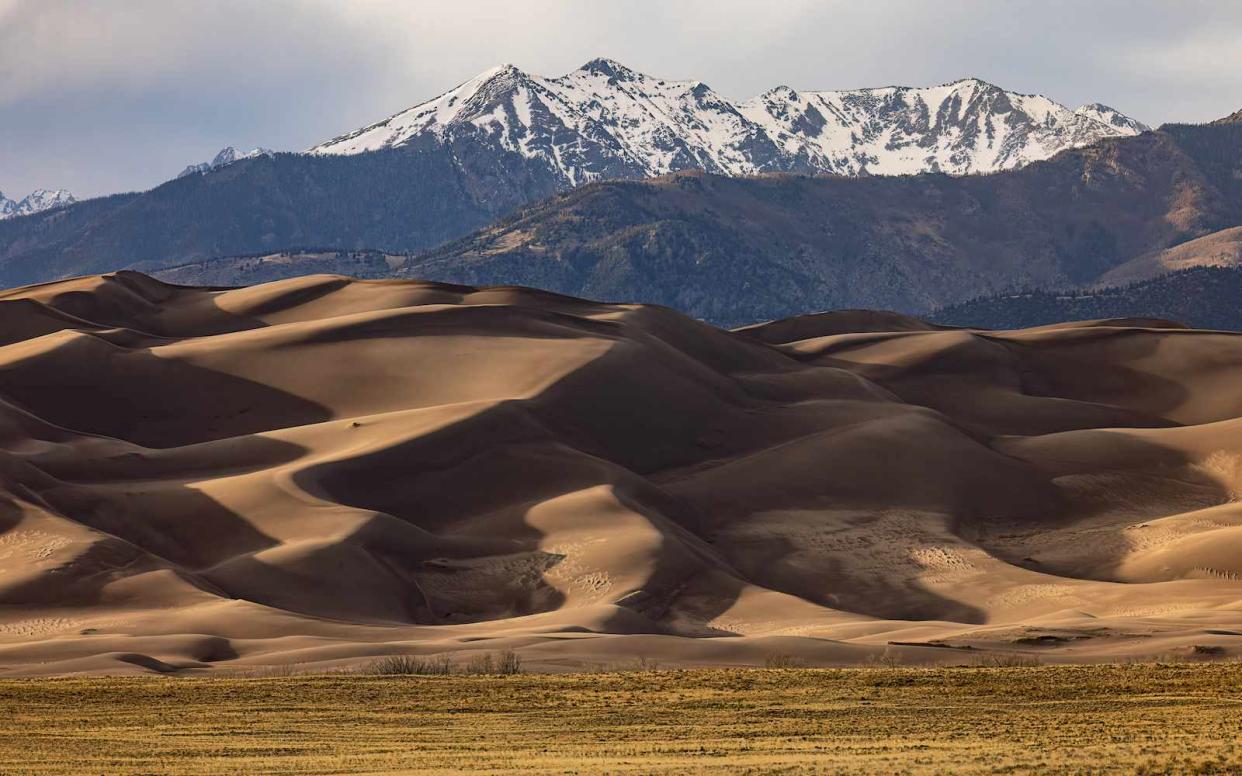
Cliff Mueller / 500px / Getty Images
Great Sand Dunes National Park can rattle your sense of geography in the most delightful of ways. In this section of southern Colorado, snow-capped alpine mountains share the horizon with undulating sand dunes drawing comparisons to both the Sahara Desert and the Swiss Alps.
Beyond the initial geographic bewilderment, the mysterious national park has more surprises in store. When air pushes through shifting sand grains, it can create a low hum making it seem as though the dunes are crooning, which was the inspiration for Bing Crosby’s hit “The Singing Sands of Alamosa.” Also, NASA has tested rovers in the park’s untamed landscape—a fun fact when you consider the region is also home to a UFO watchtower.
From sand sledding to stargazing, here are 10 things to do in Great Sand Dunes National Park, also known as Colorado’s massive sandbox.
Go Sandboarding on the Dunes
Trade snowy slopes for sandy ones. One of the most popular and unique activities in the park is schussing down the golden dunes on a sitting sled or via a board that you strap your feet into much like a snowboard. Equipment built for snow, though, won’t slide much in the sand, so leave the plastic sleds and saucers at home and instead rent specialized equipment from a local retailer. Sandboards and sleds cost about $20 a day. If you’ve got a need for speed, wax your board for a faster ride.
Splish-Splash in Medano Creek
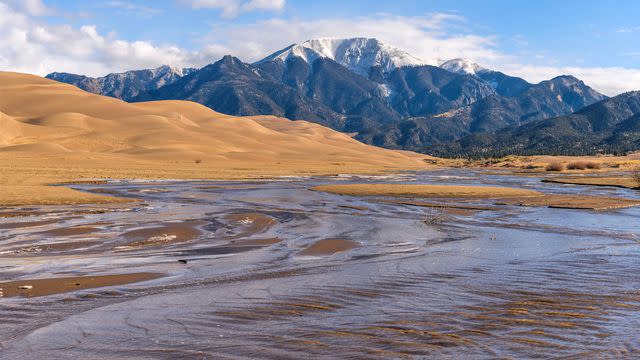
SeanXu / Getty Images
Think of Medano Creek as Colorado’s pop-up beach. Each spring, snowmelt creates a wide, shallow stream with gentle waves at the base of the dunes, providing a refreshing reprieve. Late May and early June is typically the best time to sync up your trip with “surge flow,” which is when the waves flow across the sand. If conditions are right during this window, you can splash around in the creek, go skimboarding and even take a leisurely float in an inflatable tube. Of course, sandcastle building is a must-do, too. The park system provides creek flow updates.
Stargaze in the Park
The Great Sand Dunes’ dark skies, high altitude, and dry air create near-perfect conditions for stargazing, and, in 2019, the park was designated as an International Dark Sky Park. Stargazing here is a multi-sensory experience. Not only can you see the stars studding the sky like it's a giant pin cushion, but you can listen for hooting owls and howling coyotes in the distance and smell the pinon pine and juniper perfuming the air. Late summer and fall is when the Milky Way is most visible from the park. Even in summer months, temperatures drop in the evening, so park rangers recommend bringing warm layers.
Watch the Sandhill Crane Migration
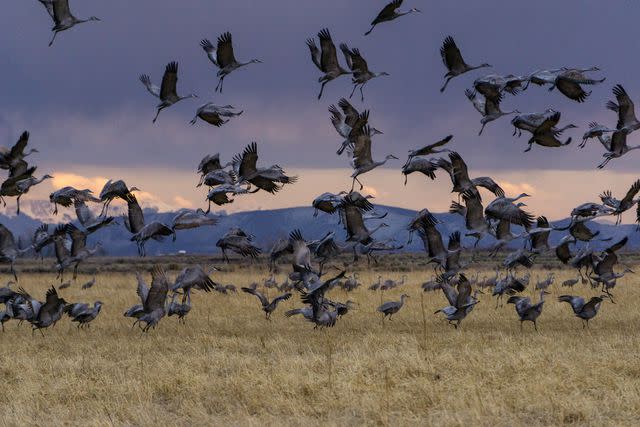
Sparty1711 / Getty Images
Birdwatchers can spot more than 200 different species in and around the park. One of the best birdwatching spectacles though is the Sandhill Crane Migration when more than 20,000 cranes descend on the San Luis Valley. The birds arrive in early February, chowing down on barley grains to fuel up before their late-March departure to the northern United States and Canada.
In the fall, the cranes revisit the valley from late September to late November. One of the best places to watch the migration is 45 minutes outside the park at the Monte Vista National Wildlife Refuge, which is an add-on to your park experience. But you can also spot the cranes from some areas in and around the park, including from County Lane 6N.
Fat Bike on Medano Pass
ATVs aren’t allowed in the park and standard mountain bikes are no match for the sandy terrain. But fat bikes, which are mountain bikes with extra wide tires, are allowed on the Medano Pass Primitive Road and can handle the extended sections of sand, though it’s a tough ride. The road crosses over creeks and riders can get nice views of the Eastern dunes and may even spot some bighorn sheep in the meadows. The road closes in the winter and you’ll want to check road conditions before bringing your bike to the park.
Explore the Park on Horseback
There are two ways to go horseback riding in the Sand Dunes. The first is to bring your own horse to the park. The second is to be a guest at the Zapata Ranch, staying on a “ranch vacation package” that requires a three-night minimum. Ranchlands, which manages Zapata Ranch, is the only licensed provider for horseback riding in the national park. Those vacationing at the ranch’s historic 17-bedroom lodge can go horseback riding in the dunes and also among a herd of 2,000 bison.
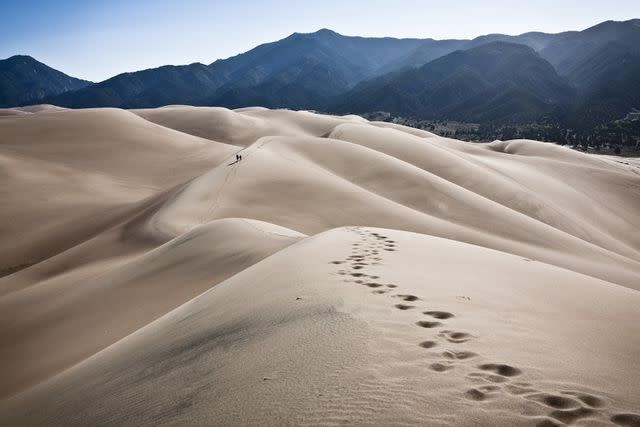
Glasshouse Images / Getty Images
Hike the Tallest Dunes in the United States
Shifting sands means there are no designated trails on the dunes, and visitors are free to roam the 30-square-mile dune field and huff it up the sandy slopes. Measuring in at 741 feet tall, Star Dune and Hidden Dune are tied for the tallest sand dunes in the United States and it takes at least 6 to 7 hours round-trip to conquer each of them. For a more approachable hike, summit the High Dune on First Ridge, which is a 2.5-mile round-trip trek that typically takes about 2 hours and comes with panoramic views of the dune field.
Something to keep in mind: High temps in the summer average 75 to 80 degrees, but the sand can be scorching hot with surface temperatures reaching 150 degrees on sunny days. When the sand is too hot, take a hike on the shady forested and alpine trails.
See (or Create) Some Otherworldly Art
The otherworldly landscape of the Great Sand Dunes has inspired several artists over the years. Pop into the Visitor Center, which has an exhibit space showcasing fine art paintings and photography of the park and preserve. Creative types can also capture the beauty of the dunes, too. Bring a sketch pad with you on your visit and follow this ranger-led tutorial on how to create your own masterpiece, allowing your “hand be like the wind when drawing a dune” and using pastels to layer on tones of gold, peach, pink, and tan. Photographers also love the dunes, with each season providing a different snapshot—like autumnal colors on cottonwood trees in the fall, snow dusting the dunes in the winter, and prairie sunflowers sprouting up in the sand in late summer.
Take Part in a Ranger Program
Have you ever wanted to go on a full moon hike in a dune field? Or listen to experts from NASA talk about deep space exploration in a national park that’s been used to test rovers because of its alien-like landscape? The Great Sand Dunes hosts several events, with free ranger events held mostly in the summer and fall.
Camp at the Base of the Dunes
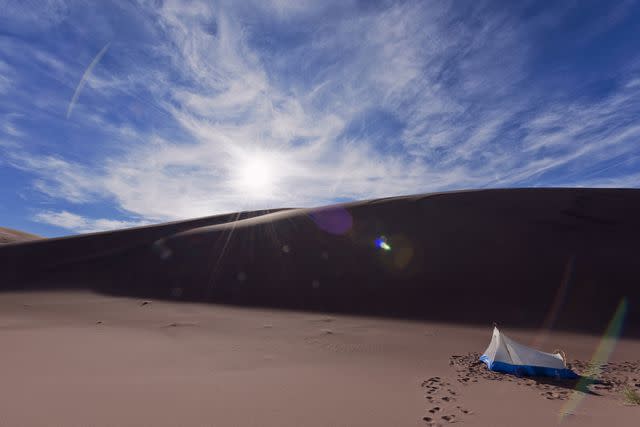
Dennis Lane / Getty Images
For an epic sleepover, reserve a campsite nestled at the base of the dunes. Just north of the Visitor Center, the Piñon Flats campground is open April through October and many sites come with great dune views. Reservations are available at recreation.gov and individual sites can be booked six months in advance while group sites can be booked a year in advance. Toast s’mores at the fire pit and wake up early to hike the dunes before they get too hot.
Read the original article on TripSavvy.

